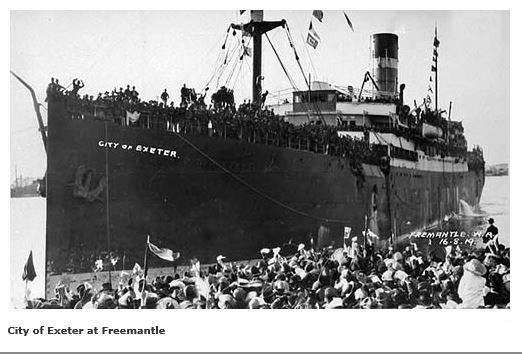Difference between revisions of "SS City of Exeter"
From Our Contribution
(→England to Fremantle 15 January - 20 February 1919) |
(→Remarks) |
||
| (8 intermediate revisions by the same user not shown) | |||
| Line 1: | Line 1: | ||
| − | {{Infobox | + | {{Infobox ship |
| − | | | + | | image = [[File:SS_City_of_Exeter.jpg]] |
| − | + | | caption = Fremantle August 1919 | |
| − | + | | image2 = [[File:SS_City_of_Exeter_3.jpg]] | |
| − | |||
| − | |||
| − | |||
| − | |||
| − | | caption = | ||
| − | | | ||
| caption2 = | | caption2 = | ||
| + | | shipname = SS City of Exeter | ||
| + | | shipowner = Ellerman Lines Ltd. (City Line Ltd. Mgr) | ||
| + | | shipbuilder = Workman Clarke & Co Ltd., Belfast | ||
| + | | shipyardnumber = | ||
| + | | shiplaunched = 1914 | ||
| + | | shipcompleted = | ||
| + | | shipinservice = | ||
| + | | shipoutofservice = 1950 | ||
| + | | shipinservice2 = | ||
| + | | shipoutofservice2 = | ||
| + | | shipreclassified = | ||
| + | | shipID = | ||
| + | | shipfate = Scrapped | ||
| + | | shiptype = tropship - cargo / passenger | ||
| + | | shiptonnage = 9,447 tons | ||
| + | | shiplength = 486.7 ft (148.31m) | ||
| + | | shipbeam = 58.9 ft (17.91m) | ||
| + | | shipdepth = 32.6 ft (9.91m) | ||
| + | | shippropulsion = twin screw | ||
| + | | shipspeed = | ||
| + | | shipcapacity = | ||
| + | }} | ||
| − | |||
| − | |||
| − | |||
| − | |||
| − | + | ==Remarks== | |
| − | + | Built for the Ellerman Lines and used as a troopship in 1914 and 1915, and again at the end of the war to return soldiers to Australia. She survived WW2 before being scrapped in 1950, seemingly under one ownership for all that time. The Ellerman Lines serviced two main routes: | |
| − | + | * Glasgow - Liverpool - Port Said - Suez - Bombay - Karachi - Kathiawar ports - East & South Africa - Continent - UK ports - Glasgow. | |
| − | + | * Glasgow - Suez - Aden - Vizagapatam - Chalna - Calcutta - Colombo - UK and Continental ports. | |
| − | |||
| − | |||
| − | |||
| − | |||
| − | |||
| − | |||
| − | |||
| − | |||
| − | |||
| − | |||
| − | |||
| − | |||
| − | |||
| − | |||
| − | + | The City of Exeter struck a mine in the Indian Ocean, about 400 miles (667 km) from Bombay. Number 1 hold filled at once, and the master gave orders for the passengers and crew to leave the ship. Then the master and chief engineer returned and, at grave risk, made a thorough examination of the ship. They decided that, with the exercise of the greatest care, the crippled vessel could reach Bombay under her own steam. The passengers reembarked and the vessel safely arrived in port | |
| − | |||
| − | |||
| − | |||
==Soldiers carried== | ==Soldiers carried== | ||
| − | ==England to Fremantle 15 January - 20 February 1919== | + | ===England to Fremantle 15 January - 20 February 1919=== |
*[[Albert John Llewellyn Reed]] | *[[Albert John Llewellyn Reed]] | ||
*[[Clarence Victor Watson]] | *[[Clarence Victor Watson]] | ||
| − | ==England to Fremantle 12 July - 16 August 1919== | + | ===England to Fremantle 12 July - 16 August 1919=== |
| − | |||
*[[Rolf Montgomery Allom]] | *[[Rolf Montgomery Allom]] | ||
*[[Harry Douglas Butcher]] | *[[Harry Douglas Butcher]] | ||
| + | *[[Leslie Norman Elkington]] | ||
*[[Henry Ivor Passmore DCM]] | *[[Henry Ivor Passmore DCM]] | ||
| + | *[[Ephraim Shepherd]] | ||
*[[John (Junior) Shepherd]] | *[[John (Junior) Shepherd]] | ||
*[[Joseph Watson]] | *[[Joseph Watson]] | ||
[[Category:Ships]] | [[Category:Ships]] | ||
Latest revision as of 00:38, 7 October 2023
Contents
Remarks
Built for the Ellerman Lines and used as a troopship in 1914 and 1915, and again at the end of the war to return soldiers to Australia. She survived WW2 before being scrapped in 1950, seemingly under one ownership for all that time. The Ellerman Lines serviced two main routes:
- Glasgow - Liverpool - Port Said - Suez - Bombay - Karachi - Kathiawar ports - East & South Africa - Continent - UK ports - Glasgow.
- Glasgow - Suez - Aden - Vizagapatam - Chalna - Calcutta - Colombo - UK and Continental ports.
The City of Exeter struck a mine in the Indian Ocean, about 400 miles (667 km) from Bombay. Number 1 hold filled at once, and the master gave orders for the passengers and crew to leave the ship. Then the master and chief engineer returned and, at grave risk, made a thorough examination of the ship. They decided that, with the exercise of the greatest care, the crippled vessel could reach Bombay under her own steam. The passengers reembarked and the vessel safely arrived in port

